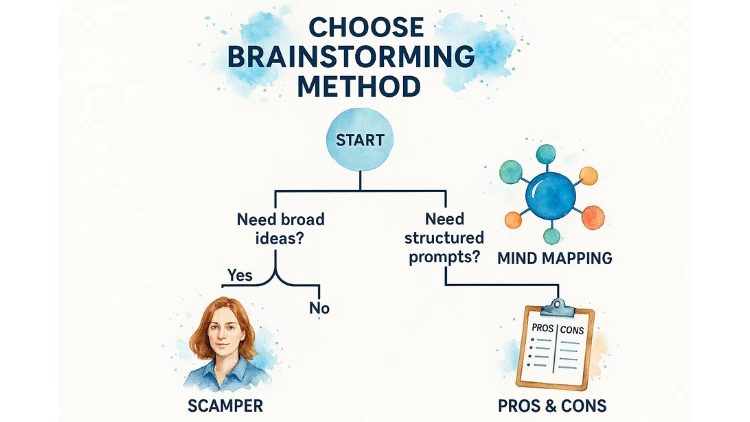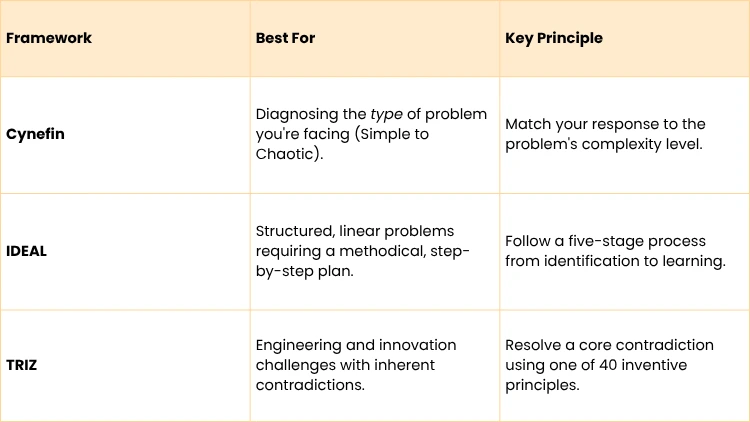How to Improve Problem Solving Skills: Top Tips & Strategies

Getting better at solving problems isn't just about finding quick answers. It's about building a reliable mental framework you can use to dismantle any challenge, figure out what's really going on, and map out the smartest way forward. Think of it less as a single skill and more as a mindset—a methodical approach of critical thinking and strategic action that applies to everything you do.
Jump To Section

Earn As You Learn
Earn 25% commission when your network purchase Uplyrn courses or subscribe to our annual membership. It’s the best thing ever. Next to learning,
of course.
Why Problem-Solving Is Your Ultimate Career Skill
In any job, what truly sets you apart is your ability to untangle tough problems. This one skill is a direct line to career growth, impressive results, and genuine leadership. As more and more routine tasks get handed over to automation, your real value isn't in ticking boxes—it's in navigating the messy, unstructured challenges that don't have an easy answer.
Think about it. When a project hits a snag, who becomes the go-to person? The one who stays calm, pinpoints the root cause, and lays out a clear plan to get things back on track. That ability to bring order to chaos is your most powerful professional asset. It proves you're competent, reliable, and have leadership potential.
The Foundation of Leadership and Innovation
Strong problem-solvers are the ones pushing a company forward. They aren't just managing their to-do lists; they're spotting opportunities to make things better and have the guts to fix operational hiccups before they escalate into full-blown crises.
That kind of proactive ownership is leadership, whether you have the title or not. It's about seeing a problem and making it your mission to solve it. For example:
- Practical Example (Software Development): A great software developer doesn’t just patch a bug. They dig deeper to understand why it happened, then refactor the code to prevent similar issues down the road. This moves from a reactive fix to a proactive improvement.
- Practical Example (Healthcare): An observant nurse in a hospital notices a repeated paperwork error and creates a simpler workflow, boosting both patient safety and team efficiency. This is problem-solving that directly impacts outcomes.
- Practical Example (Marketing): A marketing manager sees campaign engagement dropping. Instead of just throwing more money at ads, they dive into the data, identify the weak spot, and pivot the entire strategy.
The real goal of solving a problem isn't just to put out the fire. It's to walk away with a deeper understanding of the system you're working in. If you can't clearly explain your solution to a colleague, you probably haven't grasped the problem yourself.
A Skill in High Demand
The need for sharp, analytical thinkers is skyrocketing. A 2025 report from the World Economic Forum identified analytical thinking and complex problem-solving as the top skills employers are looking for globally. With technology set to reshape over one-third of all jobs in the next decade, your ability to think critically is no longer a bonus—it's essential for staying relevant.
This trend highlights a simple truth: your technical skills get you in the door, but your ability to apply them to solve new and unexpected problems is what makes you invaluable. This is one of those crucial soft skills that empower technical professionals and makes them stand out. Learning how to improve problem solving skills isn’t just a nice-to-have; it’s a direct investment in your career’s future.

How to Define the Problem You Are Actually Solving
If you want to waste time, money, and energy, start by solving the wrong problem. It’s a classic mistake. We see a symptom and immediately jump to a conclusion, slapping a bandage on a surface-level issue while the real wound festers underneath.
To get better at solving problems, you first have to get better at diagnosing them. This means fighting the impulse to brainstorm solutions right away. Instead, you need to dedicate your initial energy to truly understanding the challenge from every possible angle. It’s a crucial shift in thinking, moving from "How do we fix this?" to "What are we actually trying to fix?"
Digging Deeper with the 5 Whys
One of the most effective tools for this is the 5 Whys. It’s a deceptively simple technique developed by Sakichi Toyoda that forces you to peel back the layers of a problem by repeatedly asking, "Why?"
Practical Example: Imagine a software company notices a sudden, worrying drop in user engagement on its mobile app.
- Why has engagement dropped? We see users aren't completing the onboarding process. (That's the initial symptom).
- Why aren't they completing it? They’re getting stuck on the new "profile setup" screen.
- Why are they getting stuck? The app crashes when they try to upload a profile picture.
- Why is the app crashing? A recent update introduced a bug in the image processing library we use.
- Why wasn't this bug caught? Our automated testing protocol doesn't cover that specific library function.
See what happened? The problem we started with—low engagement—was just a sign of something much deeper. A marketing campaign to "boost engagement" would have done nothing. Fixing the bug is a good step, but the real, lasting solution is to improve the testing protocol to prevent similar issues in the future.
Frame the Problem to Guide Your Solution
Once you have a good handle on the root cause, it’s time for Problem Framing. This is all about setting clear boundaries so everyone on the team is focused on the exact same goal. Think of a well-framed problem statement as a compass for your project; it guides every decision you make from that point forward.
A strong problem frame should be:
- Specific and Measurable: Get rid of vague goals. Don't just say "Improve customer satisfaction". Instead, aim for something like, "Reduce customer support tickets related to billing by 20% in the next quarter."
- Human-Centered: Who are you solving this for? When you understand the user's perspective, you can build a solution people actually want and need.
- Action-Oriented: Write it in a way that sparks ideas. For example, phrasing it as "How might we simplify the billing process to eliminate common user errors?" invites creative thinking.
A problem well-stated is a problem half-solved. Rushing this stage is like setting off on a road trip without a map—you'll be moving, but you'll have no idea if you're getting any closer to your destination.
This discipline is your best defense against "scope creep", where a simple problem morphs into an unsolvable monster. You’re turning a messy, ambiguous situation into a clear, solvable challenge. This is especially vital for new ventures; you can dig deeper into how this works in a business context by identifying the problem-solution fit for your startup.
To get this diagnostic phase right, you have to gather and analyze information efficiently. It’s a core skill, so it’s worth taking the time to learn to process information faster. By committing to this initial step, you make sure the solution you eventually build is the right one, saving yourself a ton of effort and achieving far better results.
Building Your Toolkit with Proven Problem-Solving Frameworks
Once you've wrestled with a problem and managed to define it clearly, what's next? You need a map. Just diving in and acting on instinct might work for minor hiccups, but for the truly knotty challenges, a structured approach is your best bet. This is where problem-solving frameworks come into play—they’re battle-tested, systematic methods that keep you from getting lost in the noise.
Using a framework isn't about being rigid; it's about being effective. It gives your thinking a scaffold, making sure you examine all the critical angles, anticipate potential roadblocks, and ultimately generate more robust solutions. Think of it like a chef following a recipe for a complex dish. Their creativity and experience are still essential, but the recipe ensures they don't forget the salt.
Different Problems Need Different Tools
Not all problems are created equal. One of the biggest mistakes people make is applying the same hammer to every nail, which leads to a lot of frustration. A fantastic sense-making tool for this is the Cynefin framework (pronounced kuh-NEV-in). It helps you categorize problems based on their inherent complexity, so you can pick the right tool for the job.
Cynefin divides challenges into four main domains:
- Simple/Obvious: Here, cause and effect are crystal clear. The solution is a known best practice. Practical Example: Your printer runs out of paper. The fix is simply to refill it according to the manual. The actionable insight is to follow established procedures.
- Complicated: A clear relationship between cause and effect exists, but it takes an expert to see it. There could be several right answers. Practical Example: A car engine makes a strange noise. You bring it to a mechanic who uses their expertise to diagnose and fix the specific issue. The actionable insight is to seek expert analysis.
- Complex: You can only connect cause and effect in hindsight. There are no "right" answers, just emergent ones. Practical Example: Launching a new product into an unpredictable market. The best approach is to probe (release a minimum viable product), sense (gather user feedback), and respond (iterate on the design). The actionable insight is to experiment and adapt.
- Chaotic: All hell has broken loose, and your first job is to act decisively to restore order. Practical Example: A major server outage cripples your company's operations. The immediate goal isn't to find the root cause; it's to act now—switch to a backup server—and figure out what happened later. The actionable insight is to act decisively to stabilize the situation first.
By first figuring out which domain your problem lives in, you avoid over-engineering a simple fix or, worse, under-planning for a complex beast.
The IDEAL Method for a Step-by-Step Path
When you need a more linear, dependable process, the IDEAL model offers a clear, five-stage path from problem to solution. we find it’s perfect for things like project management and process improvement, where you need a methodical, step-by-step approach.
Let's walk through a practical example: A project manager notices her team is consistently blowing past deadlines on a key software project.
Here’s how she could use IDEAL:
- I - Identify problems and opportunities. The issue isn't just that the team is "slow". The real problem is a recurring pattern of missed deadlines that threatens the entire project launch.
- D - Define goals. The goal is to get back on schedule. The manager digs into project data and discovers the bottleneck is consistently in the QA testing phase. The problem is now clearly defined.
- E - Explore possible strategies. She brainstorms with the team and comes up with a few options: hire a temporary QA tester, reallocate developers to help with testing, or invest in automated testing software.
- A - Anticipate outcomes and Act. After weighing the pros and cons, they decide the automated testing software is the best long-term bet. She gets budget approval and moves to implement it.
- L - Look back and Learn. A month later, the manager reviews the data. The QA bottleneck is gone, and the team is back on track. Actionable Insight: The key lesson is that investing in automation for repetitive tasks is a winning strategy they can apply to future projects.
This framework gives you a repeatable structure that takes you from diagnosis to action and, most importantly, to reflection.
Getting to a solution is just the short-term goal. The real prize is deepening your understanding. If you can’t explain your solution clearly to a colleague, you haven’t truly understood it yourself.
TRIZ for Unconventional, Inventive Solutions
What happens when your problem isn't just complicated but seems like a fundamental contradiction? For those head-scratchers, you need a framework that sparks genuine innovation. That's where TRIZ comes in.
TRIZ is a Russian acronym for the "Theory of Inventive Problem Solving". It was developed by analyzing thousands of patents and is built on a powerful idea: most inventive solutions resolve a core contradiction. For instance, "How can we make a car's frame stronger without making it heavier?"
Here’s a practical example from engineering. An aerospace team needs to design a satellite component that must be incredibly durable to survive launch but also feather-light to reduce fuel costs.
- The Contradiction: Durability vs. Low Weight.
- A TRIZ Principle (Segmentation): Instead of making the part from one heavy material, they use a composite design. A lightweight honeycomb structure forms the core, while a super-durable but thin alloy creates the outer shell.
- Actionable Insight: By identifying the core contradiction, the team could apply a specific inventive principle ("Segmentation") to arrive at an elegant solution that satisfies both opposing needs. This approach can be used to innovate in any field by framing challenges as contradictions to be solved.
TRIZ offers a toolkit of 40 inventive principles like this to help you break free from conventional thinking. Developing this kind of structured creativity is a skill that powerfully complements your analytical abilities. You can explore how these skills work together in this guide on how to improve critical thinking.

Choosing Your Problem-Solving Framework
With several powerful frameworks available, it's crucial to select the one that aligns with the nature of your challenge. A mismatch can lead to wasted effort or an ineffective solution. The table below compares these methods to help you decide which one is the right fit for your situation.
Ultimately, the goal isn't just to learn one framework, but to build a toolkit. An experienced problem solver knows which tool to pull out for which job. By mastering these approaches, you're taking a huge step forward in your ability to dismantle any challenge that comes your way.

Practical Exercises to Train Your Brain for Solutions
Knowing the right frameworks is a great start, but conditioning your mind to use them instinctively is where the real magic happens. Think of it like building muscle at the gym—improving your problem-solving ability takes consistent practice. The goal is to train your brain to see challenges not as roadblocks, but as puzzles just waiting to be solved.
These exercises are your mental workout routine. They go beyond simple brain teasers to build the specific cognitive muscles you need for real-world challenges. By making them a regular habit, you'll find yourself approaching problems with more structure, creativity, and confidence.
Assumption Busting: Challenge Your Preconceived Notions
Every complex problem is tangled in a web of assumptions—the things we believe are true without even questioning them. These mental shortcuts are often the very walls that block us from finding the best solution. Assumption Busting is the deliberate practice of finding and challenging these hidden beliefs.
Actionable Insight: Grab a pen and pick a problem you're stuck on right now.
- First, list your assumptions. Write down everything you believe to be true about the situation. For example, "We don't have the budget", "This is the only way to do it", or "The client will never agree to that".
- Next, challenge each one. Go through your list and ask, "What if the exact opposite were true?" For instance, "What if we could find the budget?" or "What if the client would actually love this alternative?"
- Finally, explore the new pathways. For every assumption you flip, brainstorm what new actions you could take.
Practical Example: Imagine a marketing team assumes their new software is only for young, tech-savvy professionals, but sales are flat. By challenging this—"What if our real audience is older, non-technical managers?"—they could create a new campaign highlighting ease of use and time-saving benefits. This simple shift in perspective could open up a massive, untapped market.
Scenario Simulation: Rehearse for Future Obstacles
Ever notice how some people seem to be one step ahead of problems? It's often because they've already played out potential scenarios in their heads. Scenario Simulation, sometimes called a "premortem", is a powerful exercise where you imagine a project has already failed and work backward to figure out why.
Actionable Insight: Get your team together before your next big launch. Pose this question: "It's six months from now, and this launch was a total flop. What went wrong?" Let everyone brainstorm every possible reason for failure (e.g., "The servers crashed", "Our marketing message was unclear", "A competitor released a better feature"). You'll quickly walk away with a list of real risks you can start addressing today.
The real value here isn't just in dodging disaster. It's in forcing your brain to think critically about every single step of your plan. This almost always reveals hidden weaknesses and new opportunities for improvement.
This isn't about being negative; it's about being prepared. By identifying potential points of failure before they happen, you can build contingency plans right into your strategy from the very beginning.
Mind Mapping: Visually Untangle Complexity
Complex problems feel overwhelming because they're a messy tangle of interconnected ideas, data, and constraints. Mind Mapping is a fantastic way to visually declutter all that information, making it easier to see the relationships between different parts and find a clear path forward.
Actionable Insight: The next time you face a complex decision, take out a blank sheet of paper.
- Write your main problem in a circle in the center.
- Draw branches for key components (e.g., "Budget", "Team", "Timeline", "Stakeholders").
- From each of those, draw smaller branches for related concepts, data points, and potential solutions.
The non-linear format frees you from the rigid structure of a list, encouraging a more natural flow of ideas. This visual approach can reveal connections and insights that were totally hidden before. You can learn more about how to declutter your mind doing this mind mapping exercise to make it a regular part of your process.
Mastering the Human Side of Solving Problems
Let's be honest: a brilliant solution on paper is completely useless if you can't get people on board. Problem-solving is rarely a solo sport. It's a deeply human process that hinges on collaboration, clear communication, and a bit of well-placed influence. This is where your so-called 'soft skills' become your most powerful tools.
In a world where AI can crunch the numbers, our ability to navigate the human element is what truly sets us apart. This skill even extends to high-stakes situations, like handling social media crisis management with a steady hand.
Facilitating Brainstorms That Actually Work
We've all been in those brainstorming sessions that go nowhere. To make them truly productive, you have to create an environment of psychological safety, where no idea is too "out there" to share. In the beginning, you’re looking for quantity, not quality.
Actionable Insight: Next time you lead a brainstorm, try this structure:
- Go Silent First: Give everyone five minutes to jot down ideas on sticky notes before anyone speaks. This simple trick prevents groupthink and gives introverts a real chance to contribute without being talked over.
- Cluster and Discuss: Next, gather all the notes on a whiteboard and start grouping similar ideas. This shifts the focus away from who had the idea and onto the ideas themselves. It makes the subsequent critique feel less personal and far more constructive.
This way, you get a much wider pool of ideas on the table before anyone starts poking holes in them.
Giving Feedback That Builds Momentum
Once you have a few promising solutions, the real work of refining them begins. How you deliver feedback at this stage can either energize the team or create resentment that stalls everything. The trick is to always critique the idea, never the person.
Actionable Insight: Instead of shutting someone down with, "Your idea is too expensive", try reframing it. Use a phrase like, "I really like where this is headed. How could we get a similar result while staying within our budget?" This subtle shift invites them to solve the new problem alongside you, turning criticism into collaboration.
A great problem solver doesn't just find the right answer; they build a coalition of support around it. This requires empathy, clear communication, and the ability to see the challenge from multiple perspectives.
These skills are directly tied to your emotional intelligence. Understanding what motivates your team members and what worries them is crucial for getting a solution from a whiteboard to the real world.
Communication Is the Final, Crucial Step
So, you’ve found the root cause, picked a solution, and your core team is aligned. The last hurdle is implementation, and that’s purely a communication game. You have to clearly explain the "what", the "why", and the "how" to everyone who will be affected.
Actionable Insight: Before you roll out a solution, write down the answers to these three questions, plain and simple:
- What is changing?
- Why are we making this change?
- How will this impact you specifically?
Answering these questions upfront cuts off confusion and resistance before they start. Ultimately, the best problem-solvers we’ve known are also the best communicators. They get that a solution is only as good as its execution.

Answering Your Problem-Solving Questions
As you begin putting these methods to work, some questions are bound to pop up. This is perfectly normal. We've gathered some of the most common hurdles people encounter and answered them here to help you stay on track.
Think of this as a quick-reference guide for when you hit a snag. Let's clear up any lingering doubts so you can start practicing with confidence.
How Can I Practice Problem-Solving in My Daily Life?
This is a great question because the answer is simpler than you think: start small and be consistent. You don't need a massive work crisis to hone this skill. In fact, it's better if you don't.
Actionable Insight: Start with minor, everyday frustrations. The next time your Wi-Fi cuts out or a new recipe goes sideways, fight that knee-jerk reaction to get annoyed and just find a quick fix. Instead, take a breath and walk through a mini-version of the process:
- Ask: What's really going on here? Is it the router itself, my device, or the internet provider having an issue?
- Brainstorm: What are three different paths I could take? I could reboot the router, check the cables, or call tech support.
- Act & Learn: Pick one, try it, and see what happens. Just as importantly, make a mental note of the result for the next time it happens.
Treating these low-stakes situations like a puzzle builds the mental muscle you need for the big, high-stakes challenges at work. You can also get great practice from strategy games, puzzles, or even planning a complex vacation—anything that forces your brain to spot patterns and think a few steps ahead.
What Is the Biggest Mistake People Make When Solving Problems?
Hands down, the most common and damaging mistake is solution jumping. This is our natural tendency to grab the very first idea that sounds reasonable and run with it, all without truly understanding the problem we're facing. It’s an easy trap to fall into because it feels productive, but it almost always backfires.
When you jump straight to a solution, you're usually just slapping a bandage on a symptom. The root cause is still there, waiting to pop up again later—and it's often worse the second time around.
The goal isn't just to find an answer fast; it's to find the right answer that sticks. A rushed solution to the wrong problem is far more costly than taking the time to get it right.
Actionable Insight: To break this habit, force yourself to come up with at least three distinct potential solutions after you’ve clearly defined the problem. This simple rule forces you to look at the situation from different angles and dramatically boosts the quality of your final decision.
How Do I Know if My Problem-Solving Skills Are Actually Improving?
It can feel tough to measure the growth of a "soft skill", but there are absolutely tangible signs you can look for. You just have to know where to look—specifically, at your process and your results.
You'll know you're getting better when you start to notice a few things:
- You spend more time defining the problem. You find yourself asking more "why" questions upfront instead of rushing into brainstorming mode.
- Your solutions have fewer unintended consequences. The fixes you put in place tend to last, and they don't create a whole new set of problems to deal with.
- You feel less stressed by uncertainty. Complex challenges start to feel more like interesting puzzles to be solved rather than a source of anxiety.
But maybe the clearest sign of all is when your colleagues start coming to you with their toughest problems.
Actionable Insight: Keep a simple journal where you jot down tough situations and how you tackled them. Review it monthly. This will give you a concrete record of your progress and the new strategies you're successfully using.
Ready to turn these skills into career-defining strengths? At Uplyrn, we provide the expert-led courses and mentorship you need to master problem-solving and other critical professional abilities. Explore our courses today and start building your future.


Leave your thoughts here...
All Comments
Reply